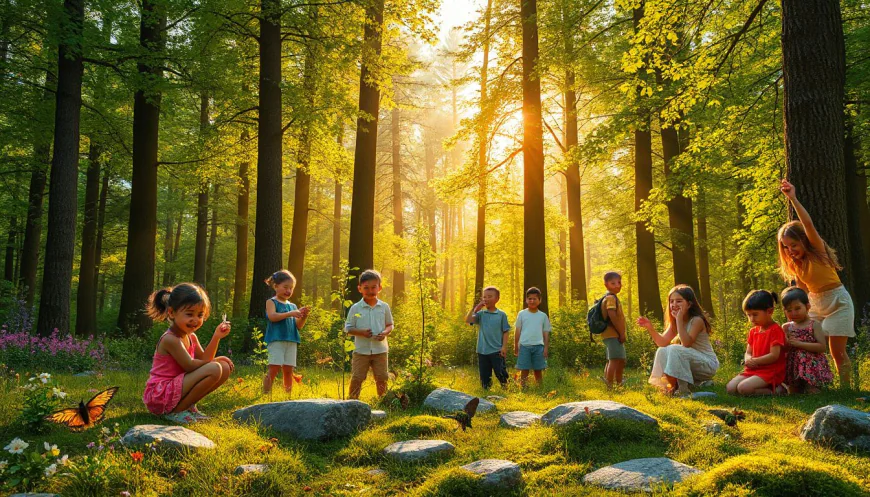Building Emotional Bonds with Nature: A Guide for Educators, Parents, and Advocates
Growing urban lives and environmental issues make it harder than ever to connect with nature. Yet, fostering emotional bonds with the outdoors is vital for our health and the planet. When we create these connections, we not only feel happier and calmer, but we also become better stewards of the environment. Educators, parents, and advocates play a key role in nurturing that love for nature. By helping others see and feel the beauty around them, we lay the groundwork for a better future.

The Importance of Building Emotional Bonds with Nature
Understanding Emotional Connections and Their Impact
An emotional bond with nature is more than just liking the outdoors. It’s about feeling a real attachment to plants, animals, and natural spaces. These feelings help us develop a sense of responsibility and care. Studies show that people with strong nature bonds are less stressed, happier, and more likely to protect the environment. This connection becomes a foundation for lifelong habits and values.
Benefits for Children and Adults
Nature isn’t just pretty—it has real health perks. Children who spend more time outside tend to improve their attention span and resilience. Adults see benefits too: lower stress, better mood, and increased physical activity. Those with deep roots in nature often become passionate environmental advocates, inspiring others to act.
The Urgency for Action
Today, many people feel disconnected from the natural world due to busy city lives and screen time. Meanwhile, environmental crises worsen daily, from climate change to habitat loss. Building bonds with nature can inspire us all to make sustainable choices. When we care deeply, we are more likely to take action to protect the planet for future generations.
Strategies for Educators to Foster Nature Connections
Integrating Nature-Based Learning
Learning outside feels different. Use outdoor classes, eco-projects, and hands-on experiments to make nature part of the curriculum. For example, some kindergartens now operate forests as classrooms, and students love it. They see firsthand how ecosystems work, sparking curiosity and respect.
Utilizing Local Ecosystems and Community Resources
Local parks, gardens, and nature trails are gold mines for teaching about wildlife and plants. Organize field trips and get involved with nearby conservation groups. Building partnerships with community organizations can help bring natural experiences right to the students or children.
Promoting Sensory and Mindfulness Activities
Encourage activities that engage all senses. Try nature journaling, sound mapping, or mindful walks. These practices deepen emotional awareness, helping children and adults feel more connected and present in the moment.
Incorporating Technology Responsibly
Apps, virtual reality, and online nature tours can be great tools. Use them to complement outdoor exploration—not replace it. The goal is to balance screen time with real-world experiences that foster genuine bonds.
Tips for Parents to Cultivate Natural Emotional Bonds at Home
Creating Nature-Rich Environments
Transform your yard into a mini wild space. Add bird feeders, insect hotels, or a small vegetable garden. Such environments attract wildlife and invite children to observe and care for living things.
Encouraging Regular Nature Experiences
Make outdoor time a habit. Plan weekly park visits, hikes, or camping trips. For toddlers, simple play in the yard works. Older children may enjoy exploring nature or taking part in outdoor sports.
Teaching Respect and Care for Nature
Show children how to treat nature with kindness. Model eco-conscious habits like recycling, conserving water, and litter cleanup. Use stories or eco-challenges to make caring for the environment fun.
Fostering Curiosity and Emotional Expression
Ask questions like “What do you see in the trees?” or “How does the bird feel sitting there?” Help children express how nature makes them feel through art, poetry, or feelings charts. These activities nurture emotional bonds and understanding.
Advocating for Community and Policy Support
Building Community Engagement Initiatives
Create local groups to explore nature together. Organize cleanup days, bird counts, or nature walks. Sharing these experiences builds a sense of community and shared purpose.
Supporting School and Local Policies
Advocate for more funding for outdoor learning spaces. Push for policies that include nature education in school curriculums. Schools that invest in outdoor programs see students display more curiosity and responsibility.
Raising Awareness and Spreading the Message
Use local media, social platforms, and community events to share stories of nature’s importance. Engage families and local leaders to participate in conservation efforts.
Overcoming Barriers and Challenges
Addressing Urban and Safety Concerns
Urban areas can feel unsafe or inaccessible. Partner with local authorities to ensure safe outdoor spaces. Use nearby green areas creatively with scheduled supervised visits.
Combating Screen Time and Sedentary Lifestyle
Encourage outdoor play over devices. Set family goals for outdoor activity. Make exploring nature a family tradition to create advantages over screens.
Maintaining Engagement During Adversities
Weather or access issues might stop outdoor plans. Use indoor gardening, virtual nature tours, or nature-themed crafts to keep the connection alive. Creativity keeps bonds strong despite obstacles.
Conclusion
Building emotional bonds with nature isn’t just a feel-good idea—it’s essential for well-being and environmental health. Everyone has a role, whether teaching children, guiding parents, or advocating for change. By taking simple steps, from outdoor lessons to backyard projects, we can nurture a lifelong love for the natural world. Together, we can create a future with healthier people and a protected planet. Start today and watch how nature transforms lives.



 VARSHITHA
VARSHITHA